www.cab.zju.edu.cn/cab/xueyuanxiashubumen/nx/bioinplant.htm 《生物信息学札记》 樊龙江
附录: 生物信息学主要英文术语及释义
Abstract Syntax Notation (ASN.l)(NCBI发展的许多程序,如显示蛋白质三维
结构的Cn3D等所使用的内部格式)
A language that is used to describe structured data types formally, Within
bioinformatits,it has been used by the National Center for Biotechnology
Information to encode sequences, maps, taxonomic information, molecular
structures, and biographical information in such a way that it can be easily
accessed and exchanged by computer software.
Accession number(记录号)
A unique identifier that is assigned to a single database entry for a DNA or
protein sequence.
Affine gap penalty(一种设置空位罚分策略)
A gap penalty score that is a linear function of gap length, consisting of a gap
opening penalty and a gap extension penalty multiplied by the length of the
gap. Using this penalty scheme greatly enhances the performance of dynamic
programming methods for sequence alignment. See also Gap penalty.
Algorithm(算法)
A systematic procedure for solving a problem in a finite number of steps,
typically involving a repetition of operations. Once specified, an algorithm can
be written in a computer language and run as a program.
Alignment(联配/比对/联配)
Refers to the procedure of comparing two or more sequences by looking for a
series of individual characters or character patterns that are in the same order
in the sequences. Of the two types of alignment, local and global, a local
alignment is generally the most useful. See also Local and Global alignments.
Alignment score(联配/比对/联配值)
An algorithmically computed score based on the number of matches,
substitutions, insertions, and deletions (gaps) within an alignment. Scores for
matches and substitutions Are derived from a scoring matrix such as the
BLOSUM and PAM matrices for proteins, and aftine gap penalties suitable for
the matrix are chosen. Alignment scores are in log odds units, often bit units
(log to the base 2). Higher scores denote better alignments. See also
Similarity score, Distance in sequence analysis.
Alphabet(字母表)
The total number of symbols in a sequence-4 for DNA sequences and 20 for
protein sequences.
Annotation(注释)
The prediction of genes
location of
protein-encoding genes, the sequence of the encoded proteins, any significant
in a genome,
including
the
125
�
www.cab.zju.edu.cn/cab/xueyuanxiashubumen/nx/bioinplant.htm 《生物信息学札记》 樊龙江
function, and
the
to other Proteins of known
matches
location of
RNA-encoding genes. Predictions are based on gene models; e.g., hidden
Markov models of introns and exons in proteins encoding genes, and models
of secondary structure in RNA.
Anonymous FTP(匿名FTP)
When a FTP service allows anyone to log in, it is said to provide anonymous
FTP ser-vice. A user can log in to an anonymous FTP server by typing
anonymous as the user name and his E-mail address as a password. Most
Web browsers now negotiate anonymous FTP logon without asking the user
for a user name and password. See also FTP.
ASCII
The American Standard Code for Information Interchange (ASCII) encodes
unaccented letters a-z, A-Z, the numbers O-9, most punctuation marks, space,
and a set of control characters such as carriage return and tab. ASCII
specifies 128 characters that are mapped to the values O-127. ASCII tiles are
commonly called plain text, meaning that they only encode text without extra
markup.
BAC clone(细菌人工染色体克隆)
Bacterial artificial chromosome vector carrying a genomic DNA insert, typically
100–200 kb. Most of the large-insert clones sequenced in the project were
BAC clones.
Back-propagation(反向传输)
When training feed-forward neural networks, a back-propagation algorithm
can be used to modify the network weights. After each training input pattern is
fed through the network, the network’s output is compared with the desired
output and the amount of error is calculated. This error is back-propagated
through the network by using an error function to correct the network weights.
See also Feed-forward neural network.
Baum-Welch algorithm(Baum-Welch算法)
An expectation maximization algorithm that is used to train hidden Markov
models.
Baye’s rule(贝叶斯法则)
Forms the basis of conditional probability by calculating the likelihood of an
event occurring based on the history of the event and relevant background
information. In terms of two parameters A and B, the theorem is stated in an
equation: The condition-al probability of A, given B, P(AIB), is equal to the
probability of A, P(A), times the conditional probability of B, given A, P(BIA),
divided by the probability of B, P(B). P(A) is the historical or prior distribution
value of A, P(BIA) is a new prediction for B for a particular value of A, and P(B)
is the sum of the newly predicted values for B. P(AIB) is a posterior probability,
representing a new prediction for A given the prior knowledge of A and the
newly discovered relationships between A and B.
Bayesian analysis(贝叶斯分析)
A statistical procedure used to estimate parameters of an underlying
126
�
www.cab.zju.edu.cn/cab/xueyuanxiashubumen/nx/bioinplant.htm 《生物信息学札记》 樊龙江
distribution based on an observed distribution. See also Baye’s rule.
Biochips(生物芯片)
Miniaturized arrays of
large numbers of molecular substrates, often
oligonucleotides, in a defined pattern. They are also called DNA microarrays
and microchips.
Bioinformatics (生物信息学)
The merger of biotechnology and information technology with the goal of
revealing new insights and principles in biology. /The discipline of obtaining
information about genomic or protein sequence data. This may involve
similarity searches of databases, comparing your unidentified sequence to the
sequences in a database, or making predictions about the sequence based on
current knowledge of similar sequences. Databases are frequently made
publically available through the Internet, or locally at your institution.
Bit score (二进制值/ Bit 值)
The value S' is derived from the raw alignment score S in which the statistical
properties of the scoring system used have been taken into account. Because
bit scores have been normalized with respect to the scoring system, they can
be used to compare alignment scores from different searches.
Bit units
From information theory, a bit denotes the amount of information required to
distinguish between two equally likely possibilities. The number of bits of
information, AJ, required to convey a message that has A4 possibilities is log2
M = N bits.
BLAST (基本局部联配搜索工具,一种主要数据库搜索程序)
Basic Local Alignment Search Tool. A set of programs, used to perform fast
similarity searches. Nucleotide sequences can be compared with nucleotide
sequences in a database using BLASTN, for example. Complex statistics are
applied to judge the significance of each match. Reported sequences may be
homologous to, or related to the query sequence. The BLASTP program is
used to search a protein database for a match against a query protein
sequence. There are several other flavours of BLAST. BLAST2 is a newer
release of BLAST. Allows for insertions or deletions in the sequences being
aligned. Gapped alignments may be more biologically significant.
Block(蛋白质家族中保守区域的组块)
Conserved ungapped patterns approximately 3-60 amino acids in length in a
set of related proteins.
BLOSUM matrices(模块替换矩阵,一种主要替换矩阵)
An alternative to PAM tables, BLOSUM tables were derived using local
multiple alignments of more distantly related sequences than were used for
the PAM matrix. These are used to assess the similarity of sequences when
performing alignments.
Boltzmann distribution(Boltzmann 分布)
Describes the number of molecules that have energies above a certain level,
based on the Boltzmann gas constant and the absolute temperature.
127
�
www.cab.zju.edu.cn/cab/xueyuanxiashubumen/nx/bioinplant.htm 《生物信息学札记》 樊龙江
from
these resampled sequences can
Boltzmann probability function(Boltzmann概率函数)
See Boltzmann distribution.
Bootstrap analysis
A method for testing how well a particular data set fits a model. For example,
the validity of the branch arrangement in a predicted phylogenetic tree can be
tested by resampling columns in a multiple sequence alignment to create
many new alignments. The appearance of a particular branch in trees
generated
then be measured.
Alternatively, a sequence may be left out of an analysis to deter-mine how
much the sequence influences the results of an analysis.
Branch length(分支长度)
In sequence analysis, the number of sequence changes along a particular
branch of a phylogenetic tree.
CDS or cds (编码序列)
Coding sequence.
Chebyshe, d inequality
The probability that a random variable exceeds its mean is less than or equal
to the square of 1 over the number of standard deviations from the mean.
Clone (克隆)
Population of identical cells or molecules (e.g. DNA), derived from a single
ancestor.
Cloning Vector (克隆载体)
A molecule that carries a foreign gene into a host, and allows/facilitates the
multiplication of that gene in a host. When sequencing a gene that has been
cloned using a cloning vector (rather than by PCR), care should be taken not
to include the cloning vector sequence when performing similarity searches.
Plasmids, cosmids, phagemids, YACs and PACs are example types of cloning
vectors.
Cluster analysis(聚类分析)
A method for grouping together a set of objects that are most similar from a
larger group of related objects. The relationships are based on some criterion
of similarity or difference. For sequences, a similarity or distance score or a
statistical evaluation of those scores is used.
Cobbler
A single sequence that represents the most conserved regions in a multiple
sequence alignment. The BLOCKS server uses the cobbler sequence to
perform a database similarity search as a way to reach sequences that are
more divergent than would be found using the single sequences in the
alignment for searches.
Coding system (neural networks)
Regarding neural networks, a coding system needs to be designed for
representing input and output. The level of success found when training the
model will be partially dependent on the quality of the coding system chosen.
Codon usage
128
�
www.cab.zju.edu.cn/cab/xueyuanxiashubumen/nx/bioinplant.htm 《生物信息学札记》 樊龙江
Analysis of the codons used in a particular gene or organism.
COG(直系同源簇)
Clusters of orthologous groups in a set of groups of related sequences in
microorganism and yeast (S. cerevisiae). These groups are found by whole
proteome comparisons and include orthologs and paralogs. See also
Orthologs and Paralogs.
Comparative genomics(比较基因组学)
A comparison of gene numbers, gene locations, and biological functions of
genes in the genomes of diverse organisms, one objective being to identify
groups of genes that play a unique biological role in a particular organism.
Complexity (of an algorithm)(算法的复杂性)
Describes the number of steps required by the algorithm to solve a problem
as a function of the amount of data; for example, the length of sequences to
be aligned.
Conditional probability(条件概率)
The probability of a particular result (or of a particular value of a variable)
given one or more events or conditions (or values of other variables).
Conservation (保守)
Changes at a specific position of an amino acid or (less commonly, DNA)
sequence that preserve the physico-chemical properties of the original
residue.
Consensus(一致序列)
A single sequence that represents, at each subsequent position, the variation
found within corresponding columns of a multiple sequence alignment.
Context-free grammars
A recursive set of production rules for generating patterns of strings. These
consist of a set of terminal characters that are used to create strings, a set of
nonterminal symbols that correspond to rules and act as placeholders for
patterns that can be generated using terminal characters, a set of rules for
replacing nonterminal symbols with terminal characters, and a start symbol.
Contig (序列重叠群/拼接序列)
A set of clones that can be assembled into a linear order. A DNA sequence
that overlaps with another contig. The full set of overlapping sequences
(contigs) can be put together to obtain the sequence for a long region of DNA
that cannot be sequenced in one run in a sequencing assay. Important in
genetic mapping at the molecular level.
CORBA(国际对象管理协作组制定的使OOP对象与网络接口统一起来的一套跨
计算机、操作系统、程序语言和网络的共同标准)
The Common Object Request Broker Architecture (CORBA) is an open
industry standard for working with distributed objects, developed by the Object
Management Group. CORBA allows the interconnection of objects and
applications regardless of computer language, machine architecture, or
geographic location of the computers.
Correlation coefficient(相关系数)
129
�
www.cab.zju.edu.cn/cab/xueyuanxiashubumen/nx/bioinplant.htm 《生物信息学札记》 樊龙江
A numerical measure, falling between - 1 and 1, of the degree of the linear
relationship between two variables. A positive value indicates a direct
relationship, a negative value indicates an inverse relationship, and the
distance of the value away from zero indicates the strength of the relationship.
A value near zero indicates no relationship between the variables.
Covariation (in sequences)(共变)
Coincident change at two or more sequence positions in related sequences
that may influence the secondary structures of RNA or protein molecules.
Coverage (or depth) (覆盖率/厚度)
The average number of times a nucleotide is represented by a high-quality
base in a collection of random raw sequence. Operationally, a 'high-quality
base' is defined as one with an accuracy of at least 99% (corresponding to a
PHRED score of at least 20).
Database(数据库)
A computerized storehouse of data that provides a standardized way for
locating, adding, removing, and changing data. See also Object-oriented
database, Relational database.
Dendogram
A form of a tree that lists the compared objects (e.g., sequences or genes in a
microarray analysis) in a vertical order and joins related ones by levels of
branches extending to one side of the list.
Depth (厚度)
See coverage
Dirichlet mixtures
Defined as the conjugational prior of a multinomial distribution. One use is for
predicting the expected pattern of amino acid variation found in the match
state of a hid-den Markov model (representing one column of a multiple
sequence alignment of proteins), based on prior distributions found in
conserved protein domains (blocks).
Distance in sequence analysis(序列距离)
The number of observed changes in an optimal alignment of two sequences,
usually not counting gaps.
DNA Sequencing (DNA 测序)
The experimental process of determining the nucleotide sequence of a region
of DNA. This is done by labelling each nucleotide (A, C, G or T) with either a
radioactive or fluorescent marker which identifies it. There are several
methods of applying this technology, each with their advantages and
disadvantages. For more information, refer to a current text book. High
throughput laboratories frequently use automated sequencers, which are
capable of rapidly reading large numbers of templates. Sometimes, the
sequences may be generated more quickly than they can be characterised.
Domain (功能域)
A discrete portion of a protein assumed to fold independently of the rest of the
protein and possessing its own function.
130
�
www.cab.zju.edu.cn/cab/xueyuanxiashubumen/nx/bioinplant.htm 《生物信息学札记》 樊龙江
Dot matrix(点标矩阵图)
Dot matrix diagrams provide a graphical method for comparing two sequences.
One sequence is written horizontally across the top of the graph and the other
along the left-hand side. Dots are placed within the graph at the intersection of
the same letter appearing in both sequences. A series of diagonal lines in the
graph indicate regions of alignment. The matrix may be filtered to reveal the
most-alike regions by scoring a minimal threshold number of matches within a
sequence window.
Draft genome sequence (基因组序列草图)
The sequence produced by combining the information from the individual
sequenced clones (by creating merged sequence contigs and then employing
linking information to create scaffolds) and positioning the sequence along the
physical map of the chromosomes.
DUST (一种低复杂性区段过滤程序)
A program for filtering low complexity regions from nucleic acid sequences.
Dynamic programming(动态规划法)
A dynamic programming algorithm solves a problem by combining solutions to
sub-problems that are computed once and saved in a table or matrix.
Dynamic programming is typically used when a problem has many possible
solutions and an optimal one needs to be found. This algorithm is used for
producing sequence alignments, given a scoring system for sequence
comparisons.
EMBL (欧洲分子生物学实验室,EMBL 数据库是主要公共核酸序列数据库之
一)
European Molecular Biology Laboratories. Maintain the EMBL database, one
of the major public sequence databases.
EMBnet (欧洲分子生物学网络)
European Molecular Biology Network: http://www.embnet.org/ was established
in 1988, and provides services including local molecular databases and
software for molecular biologists in Europe. There are several large outposts
of EMBnet, including EXPASY.
Entropy(熵)
From information theory, a measure of the unpredictable nature of a set of
possible elements. The higher the level of variation within the set, the higher
the entropy.
Erdos and Renyi law
In a toss of a “fair” coin, the number of heads in a row that can be expected is
the logarithm of the number of tosses to the base 2. The law may be
generalized for more than two possible outcomes by changing the base of the
logarithm to the number of out-comes. This law was used to analyze the
number of matches and mismatches that can be expected between random
sequences as a basis for scoring the statistical significance of a sequence
alignment.
EST (表达序列标签的缩写)
131
�
www.cab.zju.edu.cn/cab/xueyuanxiashubumen/nx/bioinplant.htm 《生物信息学札记》 樊龙江
See Expressed Sequence Tag
Expect value (E)(E值)
E value. The number of different alignents with scores equivalent to or better
than S that are expected to occur in a database search by chance. The lower
the E value, the more significant the score. In a database similarity search, the
probability that an alignment score as good as the one found between a query
sequence and a database sequence would be found in as many comparisons
between random sequences as was done to find the matching sequence. In
other types of sequence analysis, E has a similar meaning.
Expectation maximization (sequence analysis)
An algorithm for locating similar sequence patterns in a set of sequences. A
guessed alignment of the sequences is first used to generate an expected
scoring matrix representing the distribution of sequence characters in each
column of the alignment, this pattern is matched to each sequence, and the
scoring matrix values are then updated to maximize the alignment of the
matrix to the sequences. The procedure is repeated until there is no further
improvement.
Exon (外显子)
Coding region of DNA. See CDS.
Expressed Sequence Tag (EST) (表达序列标签)
Randomly selected, partial cDNA sequence; represents it's corresponding
mRNA. dbEST is a large database of ESTs at GenBank, NCBI.
FASTA (一种主要数据库搜索程序)
The first widely used algorithm for database similarity searching. The program
looks for optimal local alignments by scanning the sequence for small
matches called "words". Initially, the scores of segments in which there are
multiple word hits are calculated ("init1"). Later the scores of several
segments may be summed to generate an "initn" score. An optimized
alignment that includes gaps is shown in the output as "opt". The sensitivity
and speed of the search are inversely related and controlled by the "k-tup"
variable which specifies the size of a "word". (Pearson and Lipman)
Extreme value distribution(极值分布)
Some measurements are found to follow a distribution that has a long tail
which decays at high values much more slowly than that found in a normal
distribution. This slow-falling type is called the extreme value distribution. The
alignment scores between unrelated or random sequences are an example.
These scores can reach very high values, particularly when a large number of
comparisons are made, as in a database similarity search. The probability of a
particular score may be accurately predicted by the extreme value distribution,
which follows a double negative exponential function after Gumbel.
False negative(假阴性)
A negative data point collected in a data set that was incorrectly reported due
to a failure of the test in avoiding negative results.
132
�
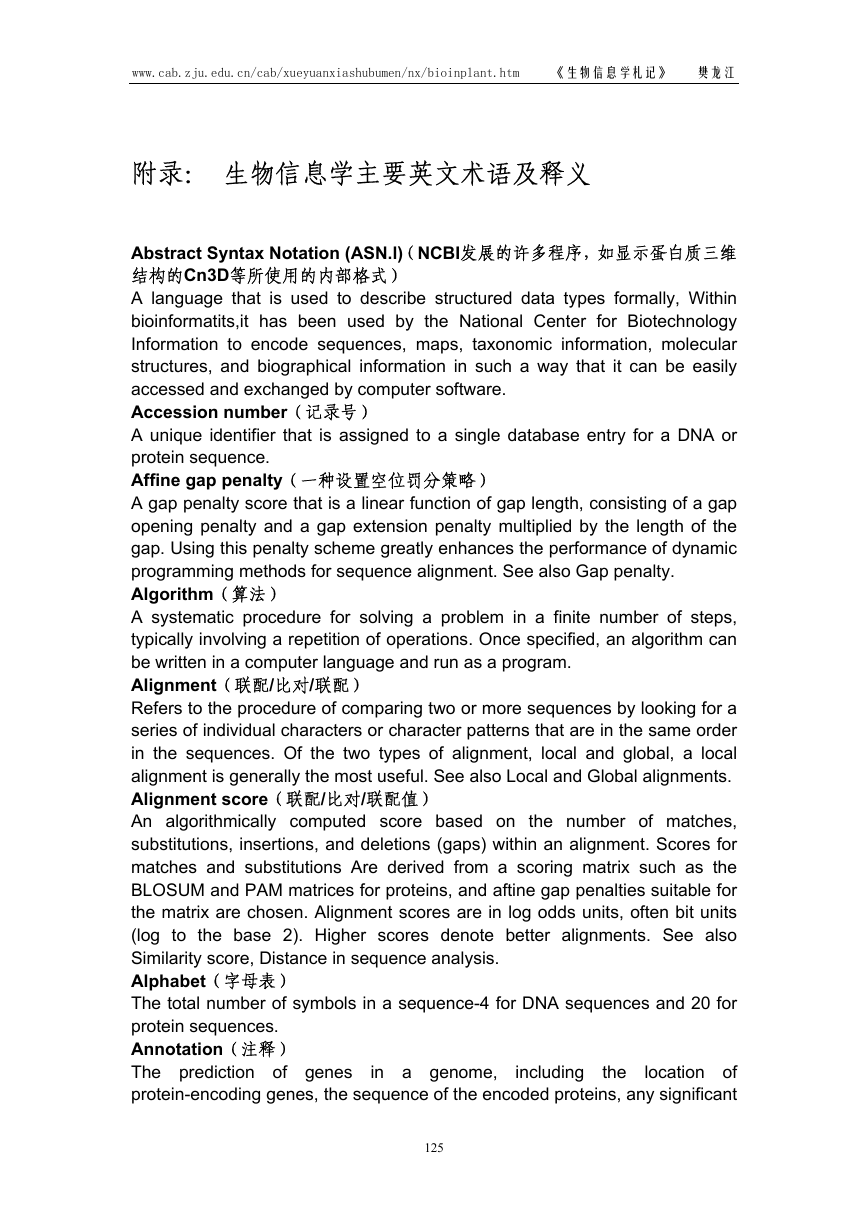
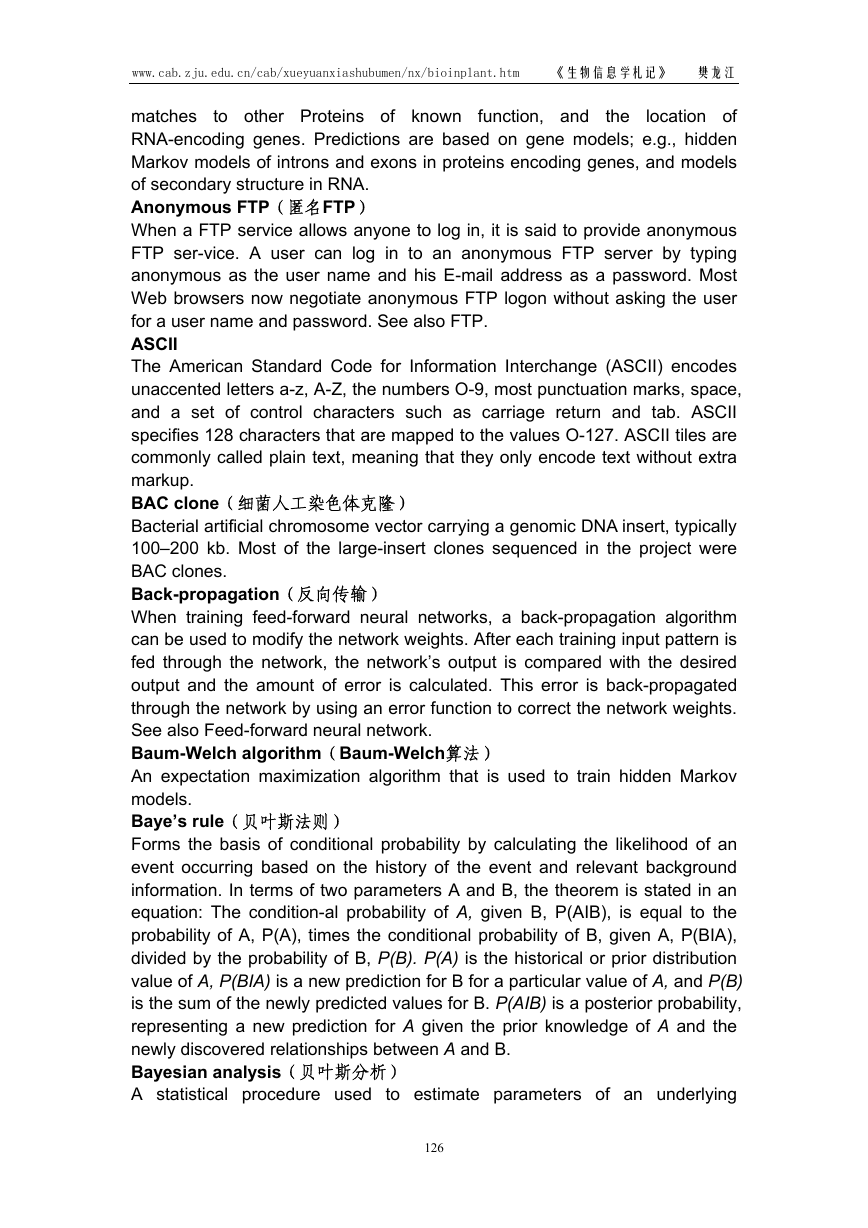
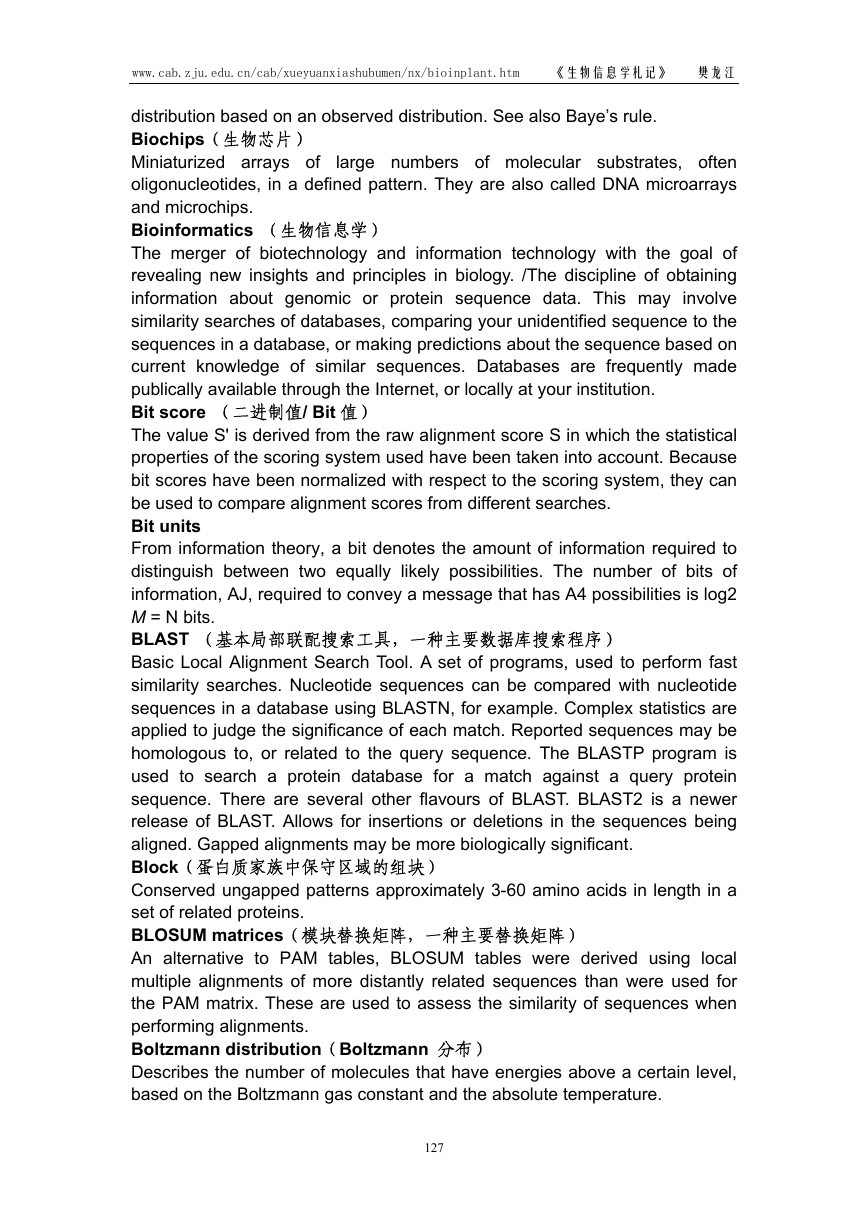
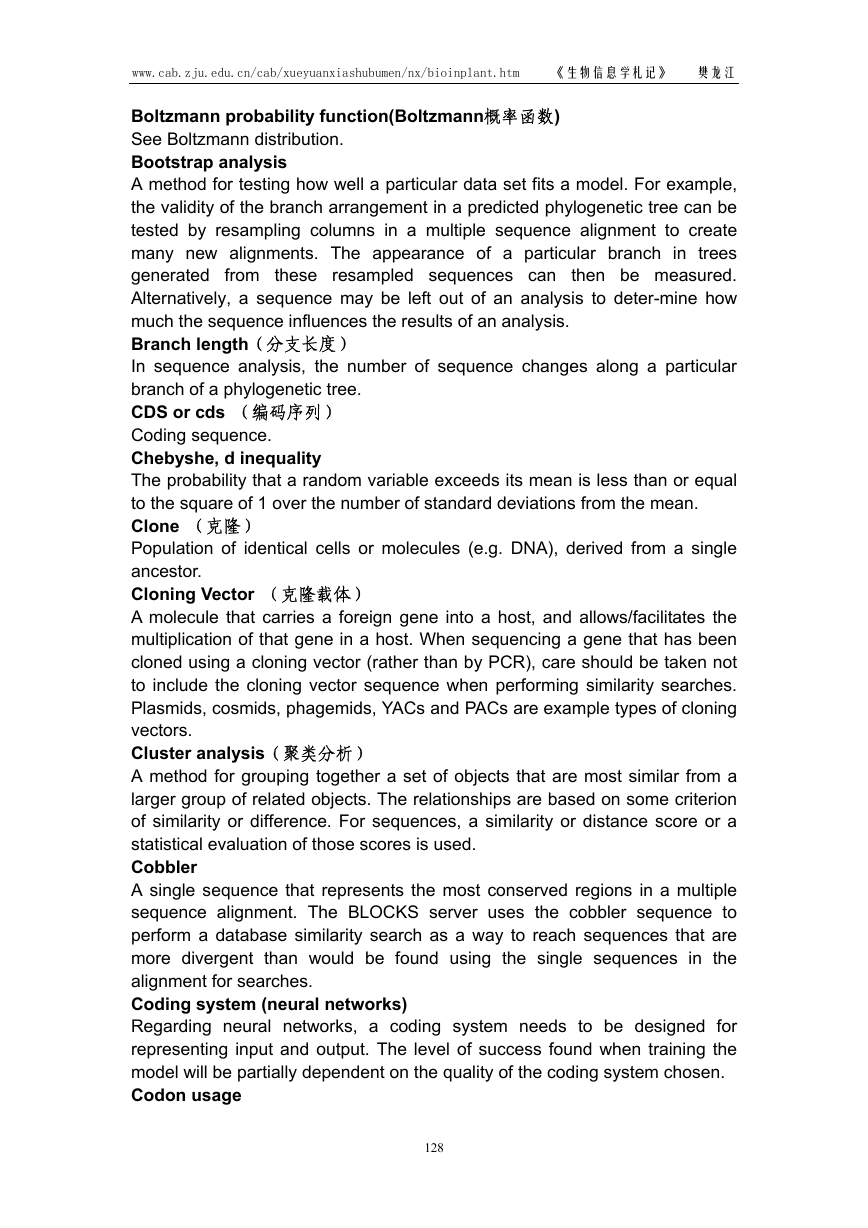
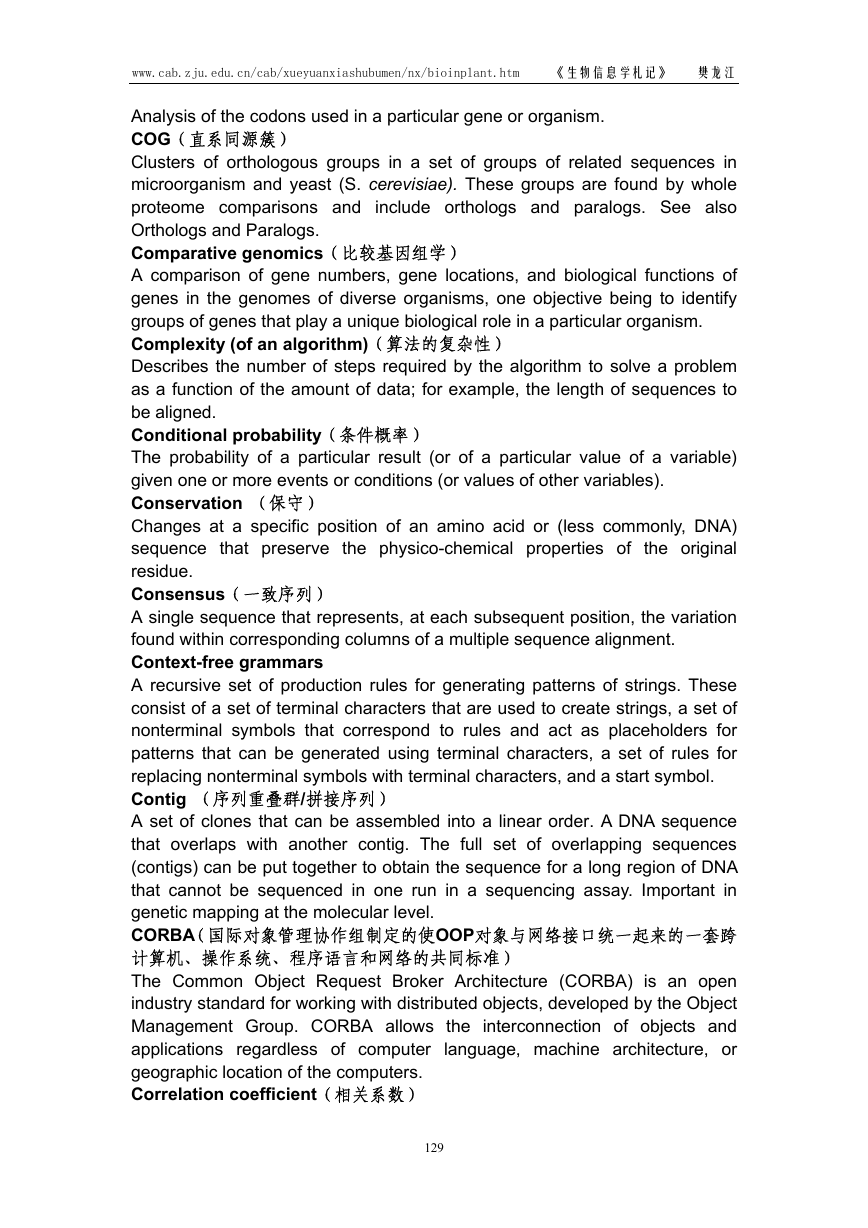
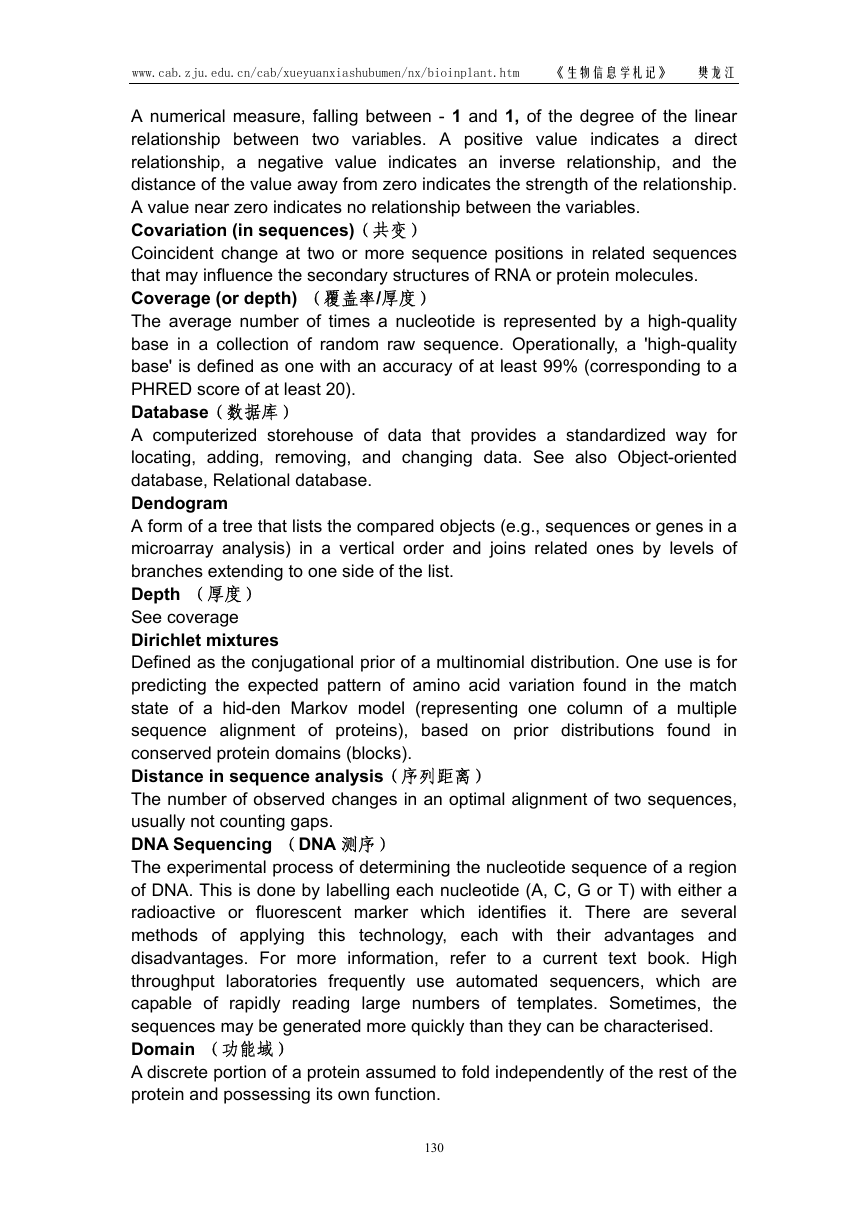
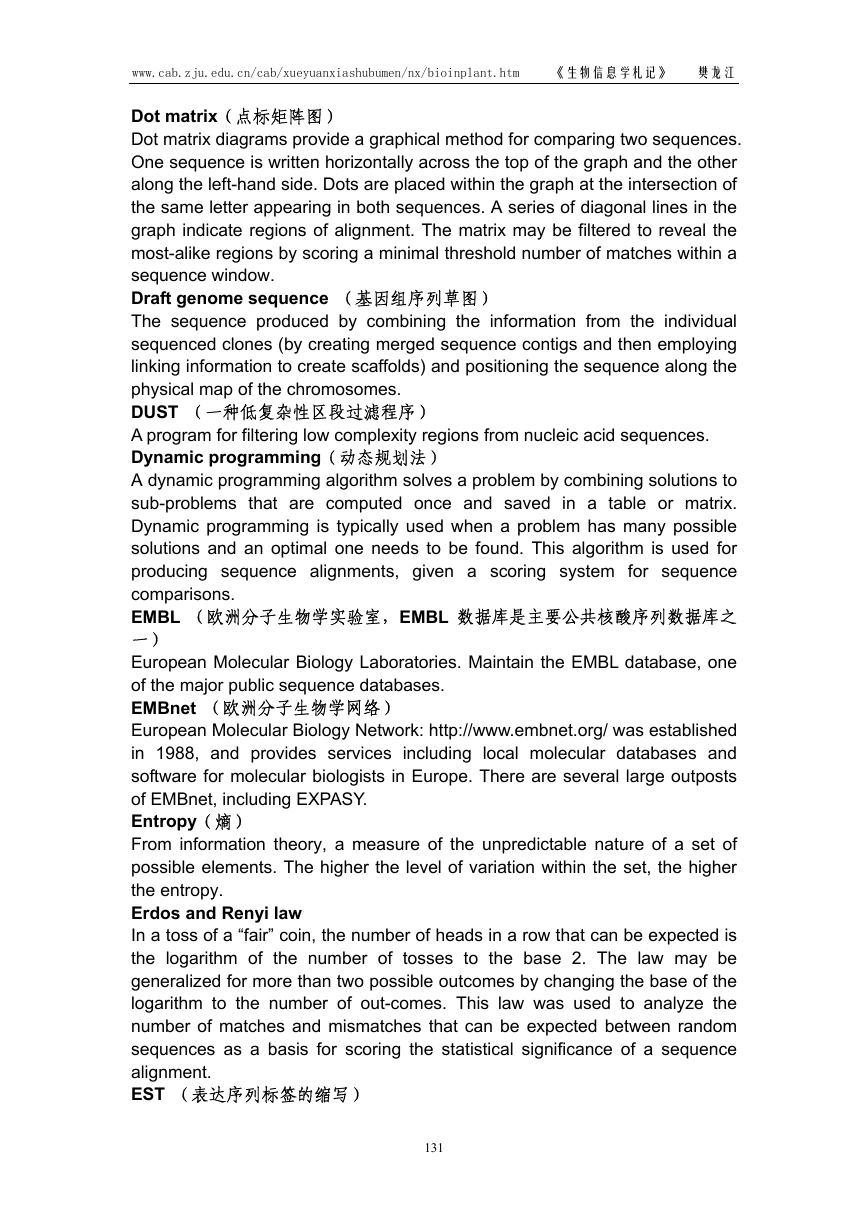
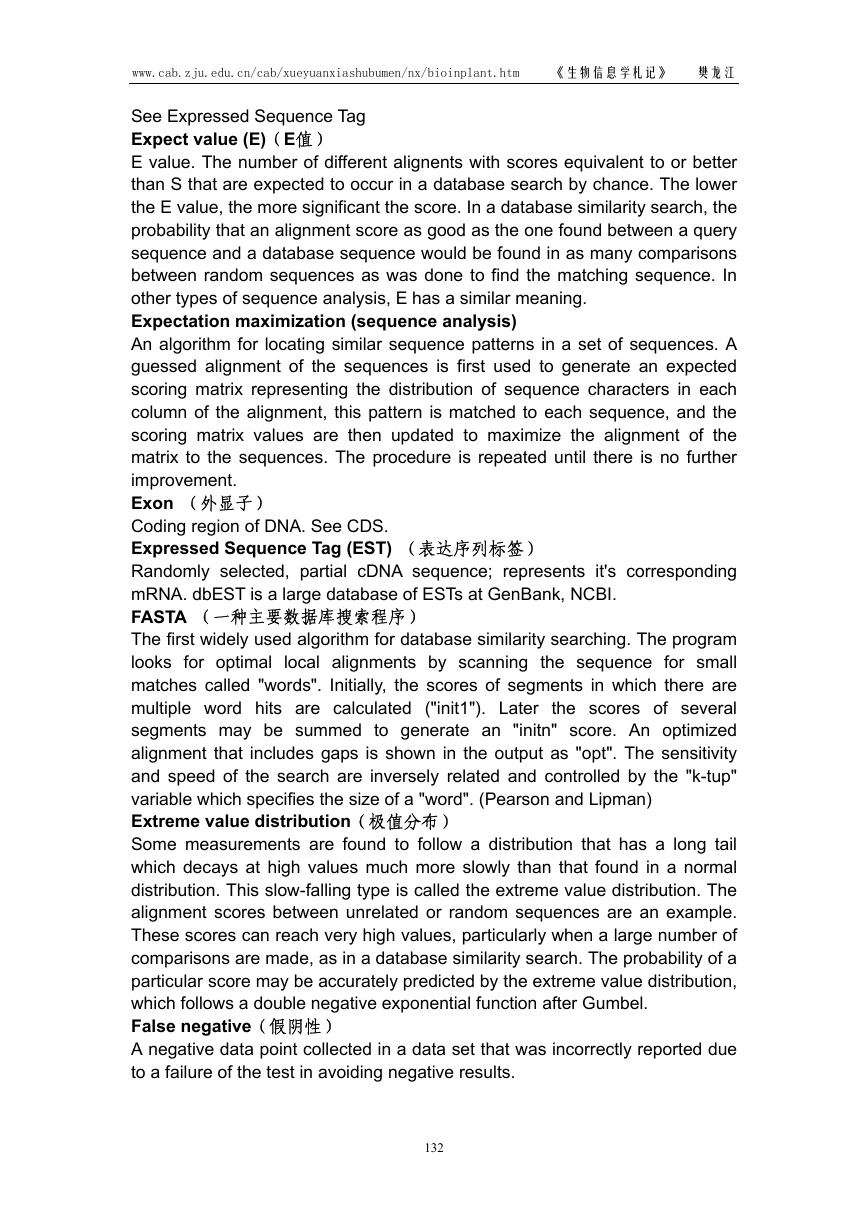








 2023年江西萍乡中考道德与法治真题及答案.doc
2023年江西萍乡中考道德与法治真题及答案.doc 2012年重庆南川中考生物真题及答案.doc
2012年重庆南川中考生物真题及答案.doc 2013年江西师范大学地理学综合及文艺理论基础考研真题.doc
2013年江西师范大学地理学综合及文艺理论基础考研真题.doc 2020年四川甘孜小升初语文真题及答案I卷.doc
2020年四川甘孜小升初语文真题及答案I卷.doc 2020年注册岩土工程师专业基础考试真题及答案.doc
2020年注册岩土工程师专业基础考试真题及答案.doc 2023-2024学年福建省厦门市九年级上学期数学月考试题及答案.doc
2023-2024学年福建省厦门市九年级上学期数学月考试题及答案.doc 2021-2022学年辽宁省沈阳市大东区九年级上学期语文期末试题及答案.doc
2021-2022学年辽宁省沈阳市大东区九年级上学期语文期末试题及答案.doc 2022-2023学年北京东城区初三第一学期物理期末试卷及答案.doc
2022-2023学年北京东城区初三第一学期物理期末试卷及答案.doc 2018上半年江西教师资格初中地理学科知识与教学能力真题及答案.doc
2018上半年江西教师资格初中地理学科知识与教学能力真题及答案.doc 2012年河北国家公务员申论考试真题及答案-省级.doc
2012年河北国家公务员申论考试真题及答案-省级.doc 2020-2021学年江苏省扬州市江都区邵樊片九年级上学期数学第一次质量检测试题及答案.doc
2020-2021学年江苏省扬州市江都区邵樊片九年级上学期数学第一次质量检测试题及答案.doc 2022下半年黑龙江教师资格证中学综合素质真题及答案.doc
2022下半年黑龙江教师资格证中学综合素质真题及答案.doc